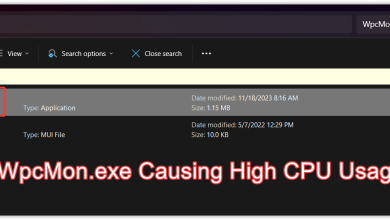How to Fix the Malwarebytes Service High CPU Problem on Windows?
Malwarebytes is a popular antivirus tool for Windows and it provides one of the best anti-malware scanners currently on the market. However, using the full suite can sometimes be difficult considering the fact that users have reported that its service sometimes demonstrates abnormally high CPU usage.

The problem persists for as long as Malwarebytes is running on your computer and it renders your PC unusable. Luckily, there are several things you can do to try and resolve the high CPU usage problem when running Malwarebytes. Check out the methods we have prepared below!
What Causes the Malwarebytes Service High CPU Problem on Windows?
Pinpointing the direct cause which causes the Malwarebytes service to consume too much CPU power is difficult. The official response by Malwarebytes is to simply perform a clean install and install the latest version, which has actually worked for many users. This means that it was a bug in the version of Malwarebytes you have installed and they managed to resolve it with the next version.
If the next version is not available, you can only check whether the other antivirus tool you have installed is causing issues by uninstalling it. If that is not the case, you can only stop the service until a patch is released!
Solution 1: Replace the Other Antivirus Tool You Are Using
Even though Malwarebytes is designed to be able to run alongside the other antivirus tool you have installed on your computer, certain free security tools have displayed incompatibility with Malwarebytes and we recommend you uninstall them. Follow the steps below in order to uninstall your other antivirus tool!
- Click on the Start menu and open Control Panel by searching for it. Alternatively, you can click on the gear icon in order to open settings if you are using Windows 10.
- In Control Panel, select to View as – Category at the top right corner and click on Uninstall a Program under the Programs section.

- If you are using the Settings app, clicking on Apps should immediately open a list of all installed programs on your PC.
- Locate your antivirus tool in Control Panel or Settings and click on Uninstall.
- Its uninstall wizard should open so follow the instructions to uninstall it.
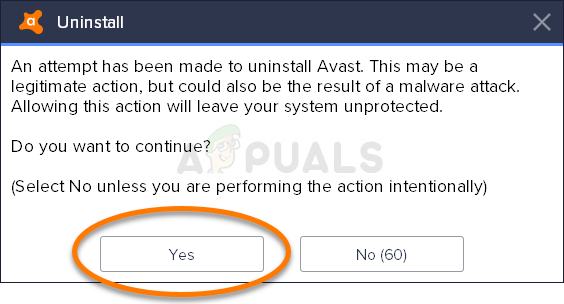
- Click Finish when the uninstaller completes the process and restart your computer to see whether errors will still appear. Make sure you choose a better antivirus option.
Solution 2: Perform a Clean Install of Malwarebytes
Plenty of users have said that reinstalling Malwarebytes from the beginning managed to resolve their issue permanently and that is something you should try as the most secure and also the longest method. However, if you purchased the Premium version of the tool, you will need to find a way to retrieve your Activation ID and Key.
- Type “regedit” in the search bar which you should be able to access after clicking on the Start menu or the Search button next to it. You can also use the Windows Key + R key combination which should open the Run dialog box where you can type “regedit” and click OK.
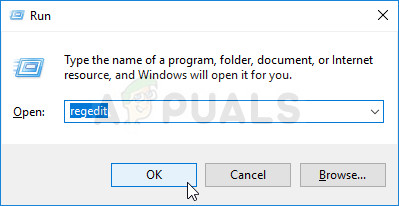
Running the Registry Editor - Use one of the locations in the registry presented below to retrieve your ID and Key, depending on your PC’s architecture:
Location for Windows x86 32-Bit:
HKEY_LOCAL_MACHINE\SOFTWARE\Malwarebytes' Anti-Malware
Location for Windows x64 64-Bit:
HKEY_LOCAL_MACHINE\SOFTWARE\Wow6432Node\Malwarebytes' Anti-Malware
After you have retrieved your ID and Key, you can proceed with the actual reinstallation process. Follow the instructions carefully if you want to continue with your Premium version after the uninstallation.
- Open MBAM >> My Account and click on Deactivate. Navigate to Settings >> Advanced Settings and uncheck the box next to the “Enable self-protection module” option.
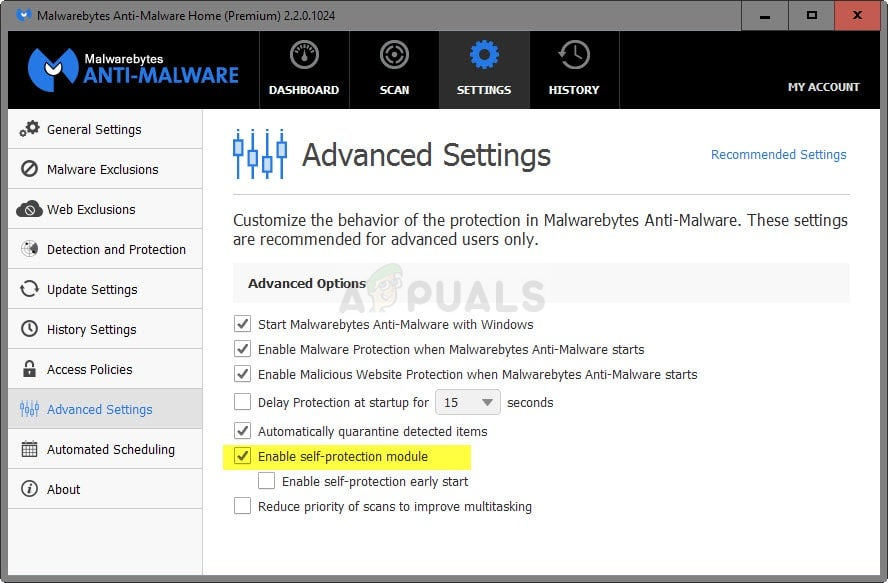
- Close MBAM and download the “mbam-clean.exe” tool from Malwarebytes’ site (the download will start immediately as you click the button). Close all open programs and temporarily disable any other security tools you may have open.
- Run the mbam-clean.exe tool and follow the instructions which will appear on the screen. Reboot your computer when prompted to do so.
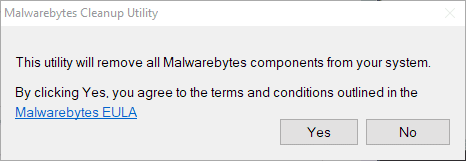
- Download the latest version of MBAM from their site and install it by following the instructions on the screen.
- Uncheck the box next to the Trial After the program launches, click on the button which says Activation. If you were using a trial, it won’t hurt to download the trial version again and skip the following step!
- Copy and paste the ID and Key you retrieved from your registry in the dialog box which should automatically activate your license.
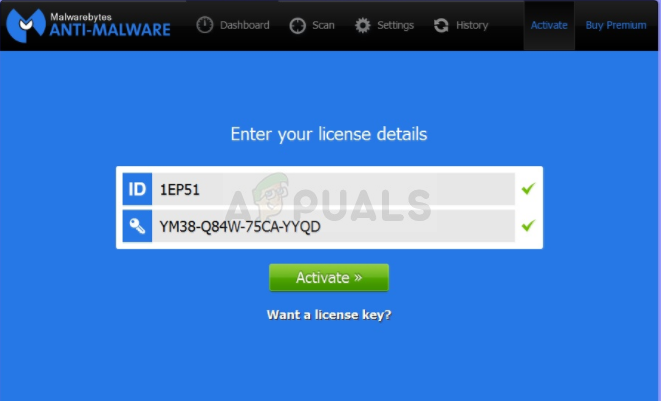
- Enjoy using Malwarebytes Anti-Malware Premium and hopefully, the error Malwarebytes service high CPU usage will disappear.
If you are not using the Premium or Pro version of MBAM, simply follow the steps 3-6 and enjoy your updated version of MBAM with no errors.
Solution 3: Stop the Malwarebytes Service from Running
Stopping the Malwarebytes service from running will effectively prevent you from running certain features such as real-time protection but you will still be able to use the malware scanner. This is a simple workaround you can use if you don’t want to uninstall Malwarebytes. As soon as an update is launched, make sure you install it and revert the changes you will make below!
- Open the Run utility by using the Windows Key + R key combination on your keyboard (press these keys at the same time. Type “services.msc” in the newly opened box without the quotation marks and click OK in order to open the Services tool.
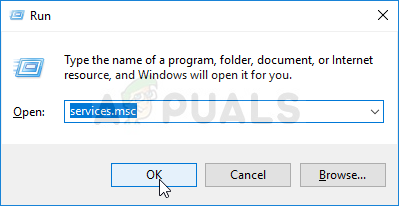
Running Services - The alternative way is to open the Control Panel by locating it in the Start menu. You can also search for it using the Start menu’s search button.
- After the Control Panel window opens, change the “View by” option at the top right part of the window to “Large Icons” and scroll down until you locate the Administrative Tools entry. Click on it and locate the Services shortcut at the bottom. Click on it to open it as well.
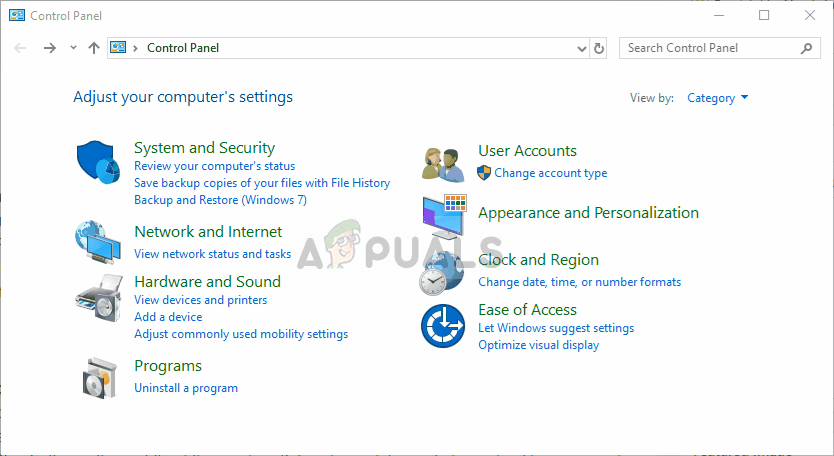
Opening Services from Control Panel - Locate the Malwarebytes Service on the list, right-click on it and select Properties from the context menu which appears.
- If the service is started (you can check that just next to the Service status message), you should stop it for now by clicking the Stop button in the middle of the window. If it is stopped, leave it stopped until we proceed.
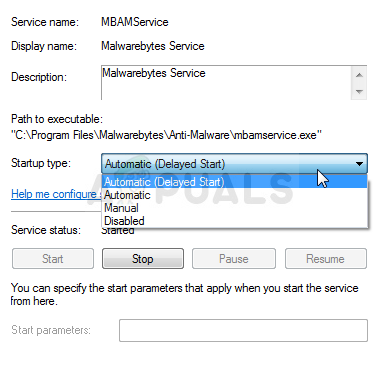
Make sure the startup type is Automatic - Make sure that the option under the Startup type menu in the service’s properties window is set to Automatic before you proceed with other steps. Confirm any dialogue boxes which may appear when changing the startup type. Click on the Start button in the middle of the window before exiting. You may receive the following error message when you click on Start:
Windows could not start the Malwarebytes service on Local Computer. Error 1079: The account specified for this service differs from the account specified for other services running in the same process.
If this happens, follow the instructions below to fix it.
- Follow the steps 1-3 from the instructions above in order to open the service’s properties window. Navigate to the Log On tab and click on the Browse… button.
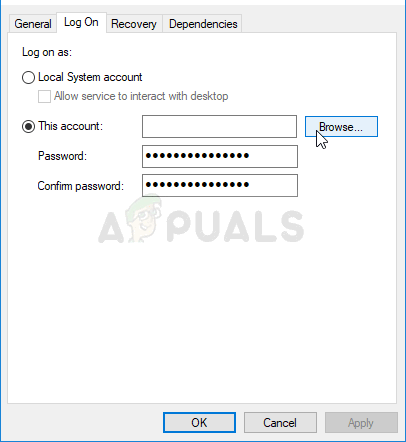
- Under the “Enter the object name to select” entry box, type in your account’s name, click on Check Names and wait for the name to become available.
- Click OK when you are finished and type in the password in the Password box when you are prompted with it if you have set up a password. Malwarebytes should now work properly.



